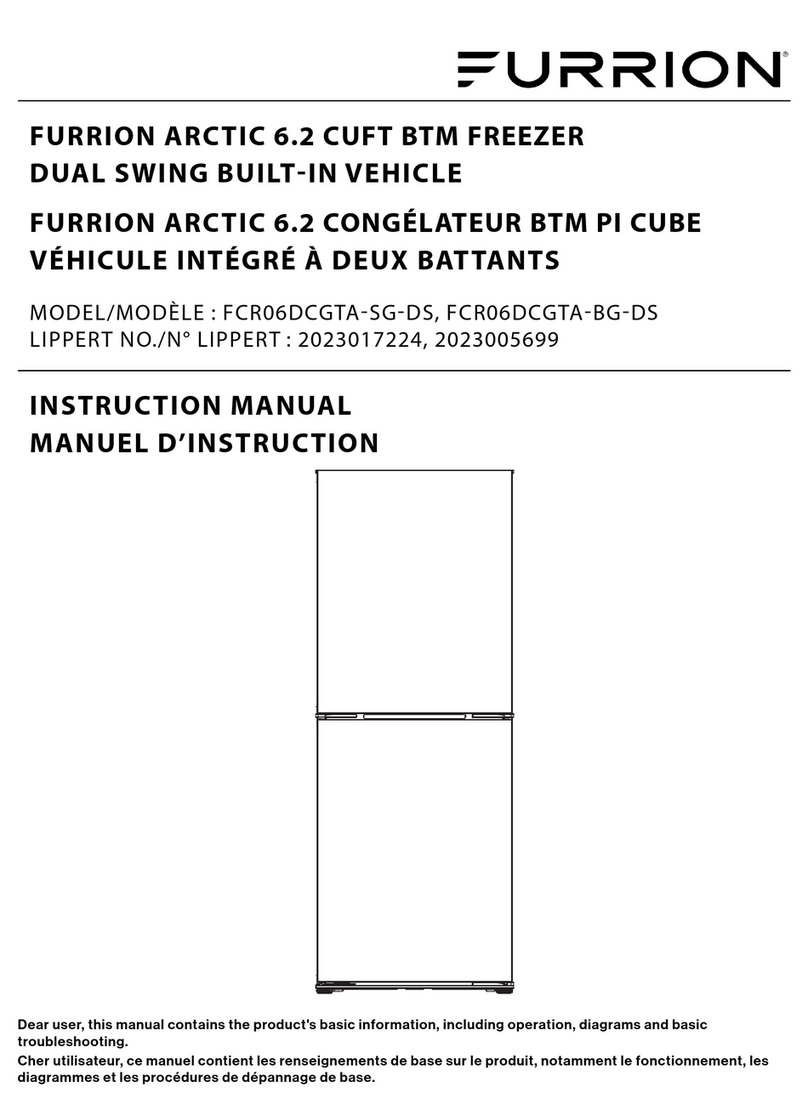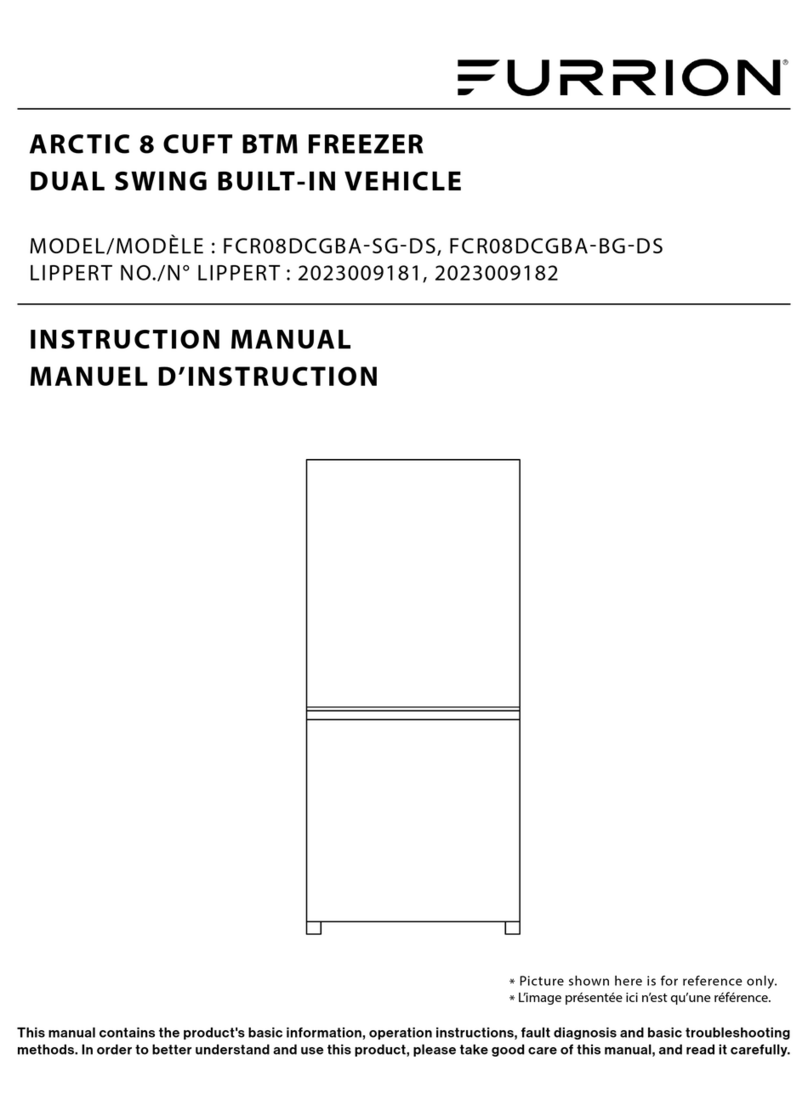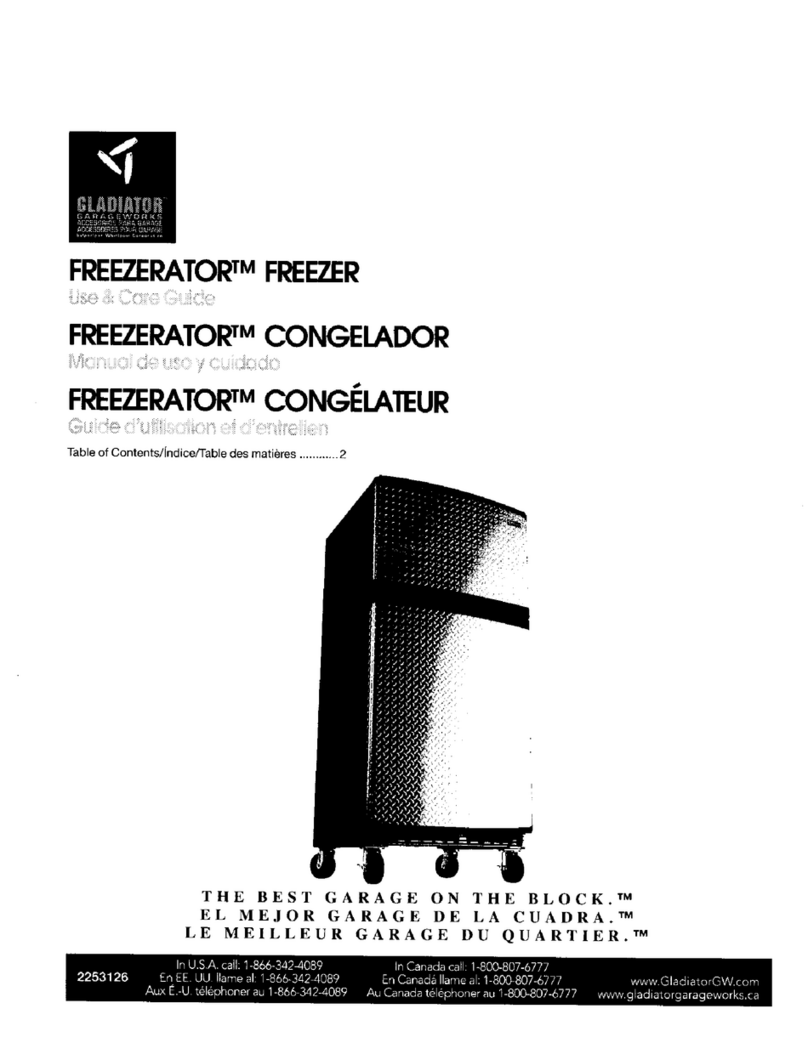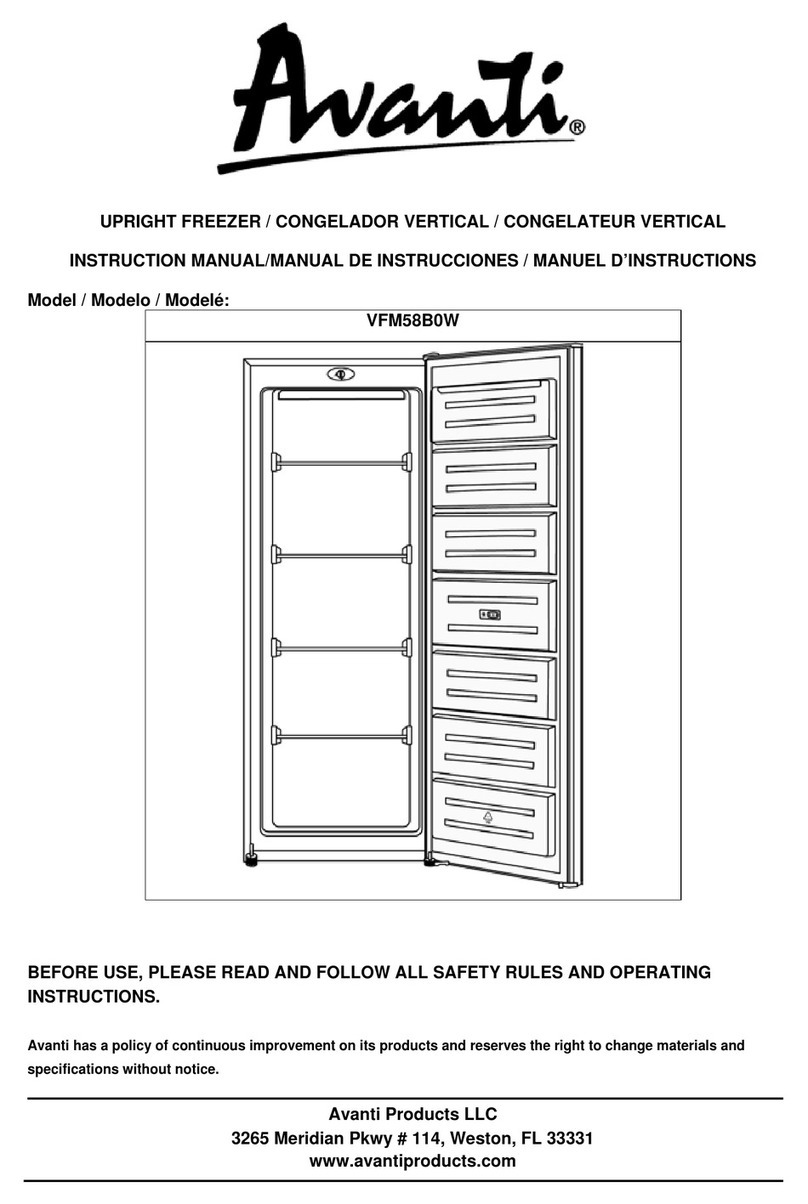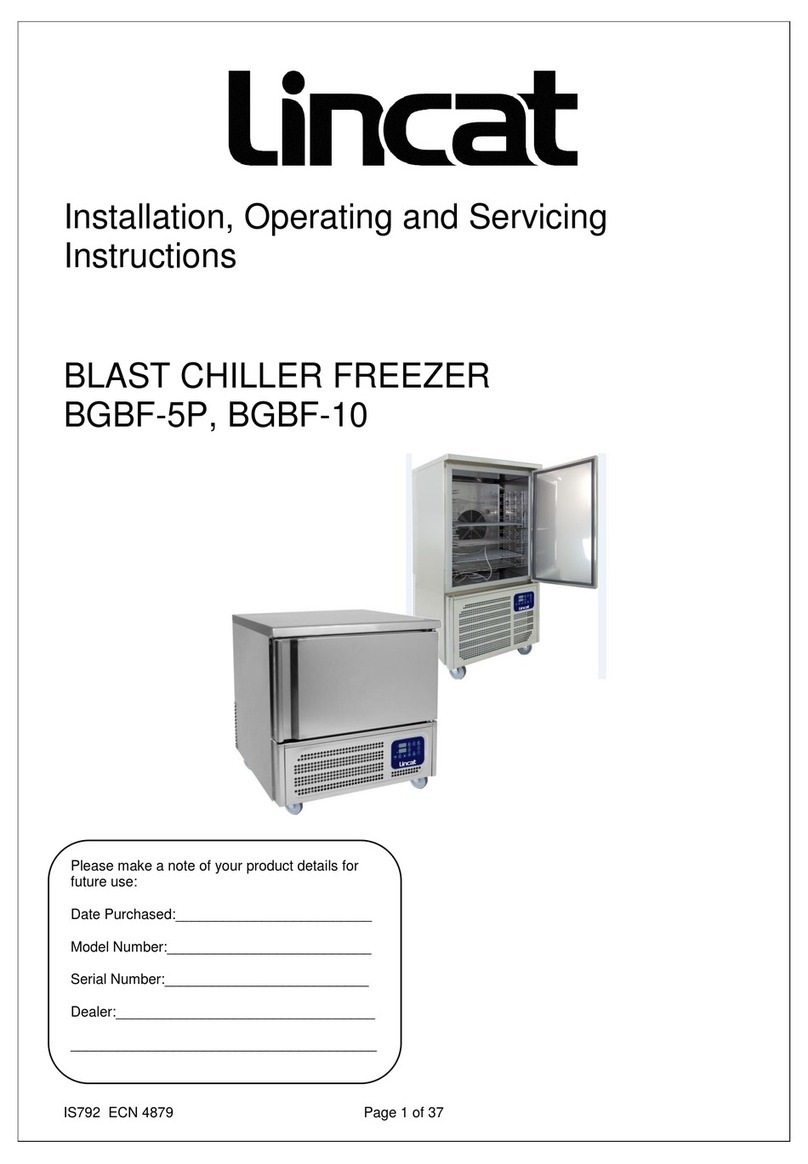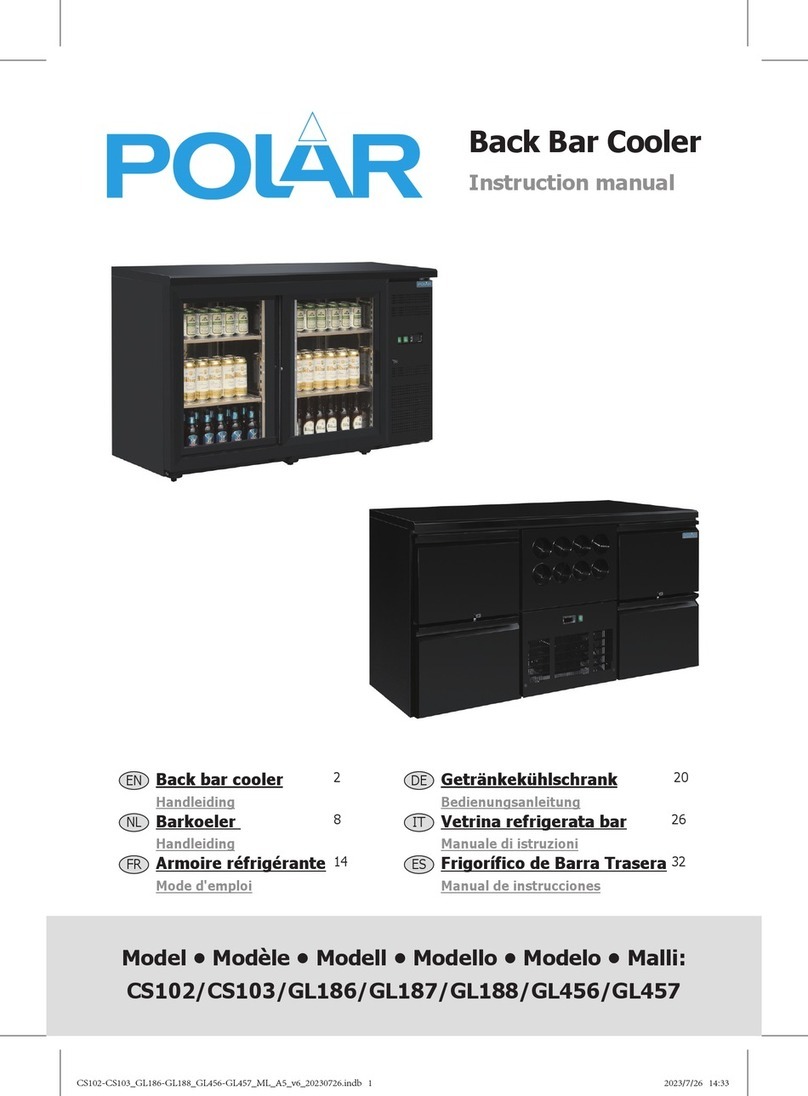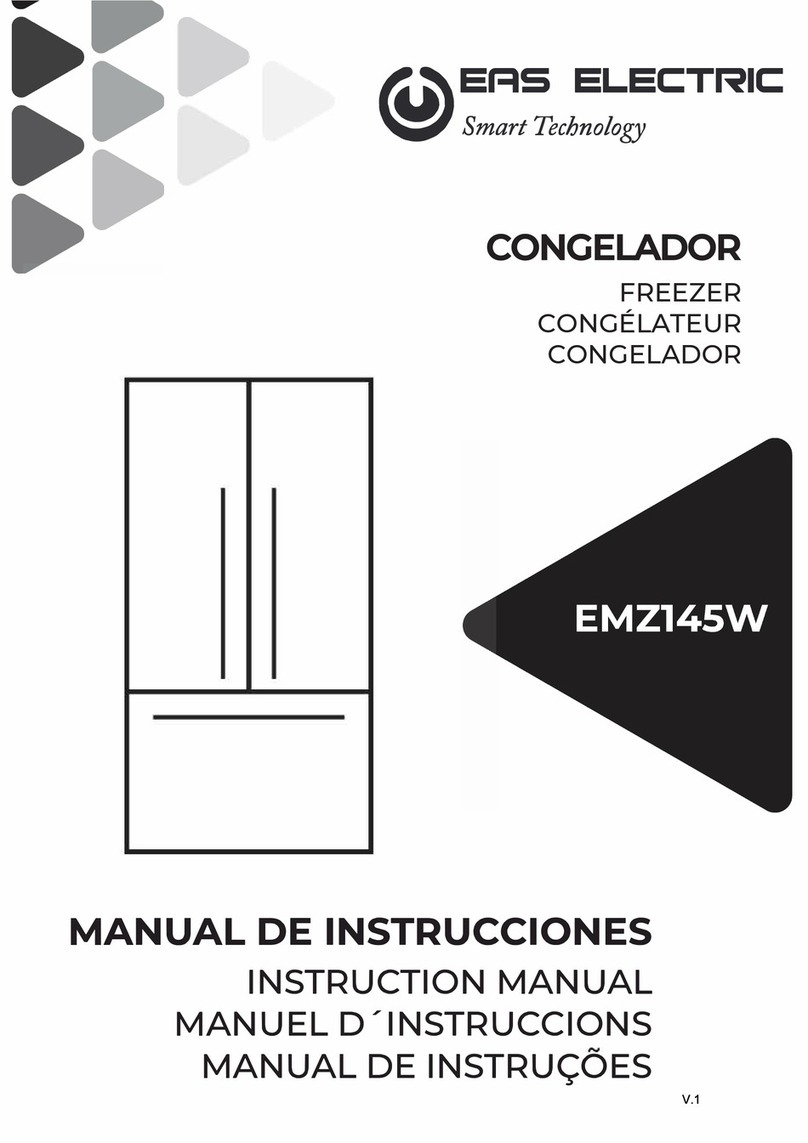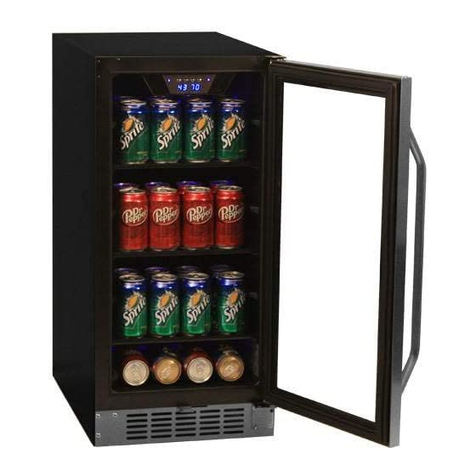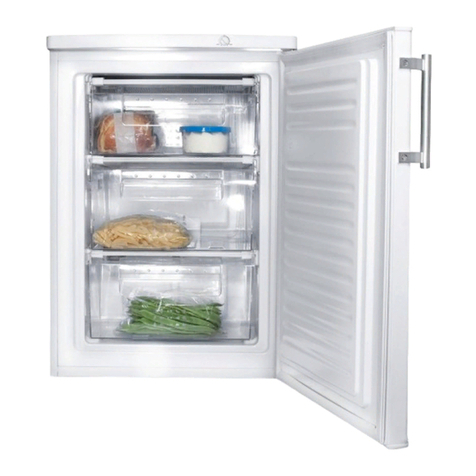Furrion FCR10DCGBA-SG-DS User manual

ARCTIC 10.2 CUFT BTM DRAWER FREEZER
DUAL SWING DOOR BUILTIN VEHICLE
MODEL: FCR10DCGBASGDS, FCR10DCGBABGDS
LIPPERT NO.: 2023049040, 2023047118
INSTRUCTION MANUAL
MANUEL D’INSTRUCTION
This manual contains the product's basic information, operation instructions, fault diagnosis and basic troubleshooting
methods. In order to better understand and use this product, please take good care of this manual, and read it carefully.
*Picture shown here is for reference only.

English
CCD-0008144 Rev: 09-05-23
- 1 -
Thank you and congratulations on purchasing this Furrion product. Before operating your new product, please read
these instructions carefully. This instruction manual contains information for safe use, installation and maintenance of
the product.
Please keep this instruction manual in a safe place for future reference. This will ensure safe use and reduce the risk of
injury. Be sure to pass on this manual to new owners of this product.
The manufacturer does not accept responsibility for any damages due to not following these instructions.
Table of Contents
Important Safety Instructions ................................................................................................................................. 2
Power Source Requirement...................................................................................................................................... 3
Features and Parts ................................................................................................................................................... 4
Preparation and Installation.................................................................................................................................... 5
Functions and Operation ......................................................................................................................................... 7
Operational Instructions.......................................................................................................................................... 8
Maintenance and Cleaning .................................................................................................................................... 10
Troubleshooting .................................................................................................................................................... 11

English
CCD-0008144 Rev: 09-05-23
- 2 -
Important Safety Instructions
CAUTION
RISK OF ELECTRIC SHOCK
DO NOT OPEN
This symbol indicates that dangerous voltage constituting a risk of electric
shock is present within your refrigerator.
This symbol indicates that there are important operating and maintenance
instructions in the literature accompanying your refrigerator.
WARNING
1. Read these instructions.
2. Keep these instructions.
3. Heed all warnings.
4. Follow all instructions.
5. Do not use your refrigerator near water.
6. Clean only with a damp cloth.
7. Do not block any ventilation openings. Follow installation process from manufacturer's instructions.
8. Do not install near any heat sources, such as radiators, heat registers, stoves, or other apparatus (including amplifiers)
that produce heat.
9. Refer all servicing to qualified service personnel. Servicing is required when your refrigerator has been damaged in any
way, such as spilled liquid, objects falling onto the refrigerator, your refrigerator being exposed to rain or moisture, or
the refrigerator does not operate properly.
10.To reduce the risk of fire or electric shock, do not expose your refrigerator to rain, moisture, dripping or splashing. No
objects filled with liquids should be placed on top of the refrigerator.
11.Your refrigerator is not intended for use by any person (including children) with reduced physical, sensory or mental
capabilities or lack of experience or knowledge, unless given supervision or instruction concerning use of your refrig-
erator by a person responsible for their safety.
12.Children should be supervised to ensure that they do not play with your refrigerator.
ELECTRIC SHOCK HAZARD
Failure to follow these instructions may result in electric shock, fire or death.
1. WARNING - Keep ventilation openings, in both your refrigerator and the build-in structure, clear of obstruction.
2. WARNING - Do not touch the interior of your refrigerator with wet hands. This could result in frostbite.
3. WARNING - Do not use mechanical devices or other means to accelerate the defrosting process, other than those
recommended by the manufacturer.
4. WARNING - Do not damage the refrigerator circuit.
5. WARNING - Do not damage the refrigerant tubing when handling, moving or using your refrigerator.
6. WARNING - DANGER - Never allow children to play with, operate or crawl inside your refrigerator.
Risk of children entrapment. Before your throw away your old refrigerator:
Remove the electrical connection wiring and also ensure that the doors are removed and leave the shelves in place to
prevent children from being trapped inside - DANGER OF SUFFOCATION!

English
CCD-0008144 Rev: 09-05-23
- 3 -
Power Source Requirement
This appliance is a Class III appliance, which must only be connected to a 12 Volt power source.
The circuit must be protected properly between the appliance and power supply main, 15A min, 20A max is acceptable.
Do not use auto resetting or minibreaker type circuit protection.
Before using, disconnect the appliance from main power supply and wiring connections should be made according to
the wiring diagram.
For normal use, the connection to the power source connection must meet the following requirements:
Wire Size The Max Length (Feet)
14 AWG 10 Feet
12 AWG 20 Feet
10 AWG 30 Feet
8 AWG 45 Feet
6 AWG 60 Feet
Remarks
The DC unit is not equipped with a power source. Please purchase a power source from an
authorized dealer.
For maximum battery performance ensure the voltage drop between each power source
(battery & converter) and the refrigerator does not exceed 0.4V DC.
Note: Only authorized or qualified professionals should perform repair services for this appliance.
Wire Connection Diagram
1. Connect terminal with Positive pole of 12V DC.
2. Connect terminal with Negative pole of 12V DC.
3. If the unit is installed in an RV, the GND terminal should be connected directly to the RV chassis.
7. WARNING - Do not use electrical appliances inside the food storage compartments of the refrigerator unless they are
of the type recommended by the manufacturer.
8. Maintenance - Disconnect the power source from your refrigerator before carrying out user maintenance on it.
9. If a component part is damaged, it must be replaced by the manufacturer, its service agent, or similar qualified per-
sons to avoid a hazard.
10. Follow local regulations regarding disposal of your refrigerator due to flammable refrigerant and gas. All refrigeration
products contain refrigerants, which under the guidelines of federal law must be removed before disposal. It is the
consumer's responsibility to comply with federal and local regulations when disposing of this product.
11. Do not store explosive substances such as aerosol cans with a flammable propellant in this device.
12. This appliance is intended to be used in the recreational vehicle.
13. When user cannot open the door at one side, please check if the other side of the door is fully closed. Users are only
allowed to open the door when one side is fully closed.
14. WARNING - To avoid a hazard due to instability of the appliance, it must be fixed in accordance with the instructions.
ð

English
CCD-0008144 Rev: 09-05-23
- 4 -
Features and Parts
Control Panel
Glass shelf
Crisper drawer
Fridge door
shelf
Freezer drawer

English
CCD-0008144 Rev: 09-05-23
- 5 -
3. Level ground:
To ensure proper function, the refrigerator must be placed on a flat, firm and stable surface resting level on four
supports.
Unobstructed ventilation shall be maintained around the refrigerator or an embedded structure.
Preparation and Installation
Site preparation and installation
1. Ventilation requirements:
The position you select for the refrigerator installation should be well-ventilated with minimal hot air. Do not place
your refrigerator close to a heat source and avoid exposure to direct sunlight to guarantee optimum refrigerator
performance with minimum energy use.
2. Heat dissipation space:
During operation, the unit gives off heat to surroundings. Ensure that there is adequate space between the refrigerator
and neighboring walls or large objects. A minimum spacing of 25.4mm (1.0”) is highly recommended on the top, on
both sides and at the backside of the refrigerator.
Dimensions suggested below:
W D H A B C(°) E F
600mm (23.62") 665mm (26.18") 1520mm
(59.84") 888mm (35.0") 1210mm
(47.64") 125+2 Minimum
25.4mm (1.0")
Minimum
25.4mm (1.0")
Refrigerator unit preparation
1. Packaging:
Remove all packaging, including the foam backing at the bottom of refrigerator and the tape fixing accessories in the
box.
2. Standing time:
Place the refrigerator in a proper up-right position for more than one hour before connecting power to ensure
refrigerant settling for its normal operation.
3. Cleaning:
Make sure the accessory parts inside the refrigerator are present and the inside is wiped with a soft cloth.

English
CCD-0008144 Rev: 09-05-23
- 6 -
5. Fixing the shelves in the refrigerator compartment:
The glass shelves in the refrigerator compartment are affixed in production for safety considerations. The shelves can be
adjusted to different heights by removing the two screws that attach the retention bracket. For safety, reattach the
retention bracket using the same screws that were removed.
6. Door and drawer function:
The refrigerator doors function as Dual Swing door style, the user can open the door freely on both sides. The freezer
is a bottom drawer that slides out. All doors incorporate a self latching mechanism to retain the doors from opening
during travel. Ensure the latches and handles function properly.
7. Leveling:
Make sure to level your refrigerator using the front leveling feet. If not leveled properly, the refrigerator door gasket's
sealing performance will be affected, or it may even lead to operating failure of your refrigerator.
8. Power-on:
After completing the standing time requirement, connect the refrigerator to the dedicated power supply battery in the
RV, then the compressor will start working. Open the freezer door after 1 hour to check operation. If the compartment’s
internal temperature drops significantly, it indicates the refrigeration system is working normally.
Holes to fix the refrigerator to
the cabinet
Note: Center of mounting
hole is 51mm (2") from the
front edge of the refrigerator
cabinet.
4. Fixing the refrigerator to the cabinetry:
The refrigerator can be affixed to the RV cabinetry by installing the screws provided, or a similar Pan Head type where
the shank connects into the backer support by 25mm (1"). Screw into the holes on the inner compartment, as shown
below:

English
CCD-0008144 Rev: 09-05-23
- 7 -
Functions and Operation
"FRIDGE/FREEZER", "+", and "–": the buttons to set temperature of fridge and freezer compartments.
Press "FRIDGE/FREEZER" to enter the temperature setting mode and switch between the fridge temperature and the
freezer temperature.
Press "+" or "–" to set the temperature.
Fridge temperature "+" setting cycle: 1°C à7°C (34°F à45°F)
Fridge temperature "–" setting cycle: 7°C à1°C (45°F à34°F)
Freezer temperature "+" setting cycle: -18°C à-12°C (0°F à10°F)
Freezer temperature "–" setting cycle: -12°C à-18°C (10°F à0°F)
Press "FRIDGE/FREEZER" for 3 seconds to switch between "C" and "F".
If there is no operation for 5 seconds, it will automatically exit the setting mode and enter the display mode.
1.2 Power off:
Hold on "POWER" button for 5 seconds to turn off the refrigerator for any extended period of non-use.
2. Battery Monitor:
When the communication is normal, the digital tube displays the fridge setting temperature.
"Normal": Normal voltage range: 10.4~14.8V
"OV ALM": Over voltage alarm: >=14.8V
"UV ALM": Under voltage alarm: <=10.4V
When the voltage is too high, "OV ALM" icon will turn on. Meanwhile, there will be a beeping sound for 3 seconds to
remind the user.
When the voltage is insufficient, “UV ALM” icon will turn on. Meanwhile, there will be a beeping sound for 3 seconds to
remind the user.
3. Deactivating the defrosting function:
In the voltage display mode, press and hold "+" for 5 seconds to deactivate the defrosting function, and the control
screen will alternately display voltage / "HC".
After 48 hours, the normal defrosting function will be restored.
4. Error Codes:
Error Code Display panel lights up Beeping alarm Failure description
E6 NO Ambient temperature sensor failure
E2 NO Fridge sensor failure
E3 NO Freezer sensor failure
E4 NO Frosting sensor failure
E0 YES Door alarm (fridge door open more than 5 minutes)
EC YES Communication failure
E1 "OV ALM" icon turns on YES Over voltage alarm
E1 "UV ALM" icon turns on YES Low voltage alarm
EF NO Fan failure
E5 NO Compressor start failure
1. Functions:
Press and hold on "POWER" button for 5 seconds to activate the control panel.
The digital tube displays the fridge setting temperature in the normal state, and exits the display mode in
the setting mode.
1.1 Temperature setting:

English
CCD-0008144 Rev: 09-05-23
- 8 -
Operational Instructions
1. Operational Precautions:
●Do not operate the appliance below the operating temperature range for extended periods of time. This might effect
the appliance's performance in the long term.
●The internal temperature could be affected by factors like the location of temperature and frequency of door opening,
etc.
●Drinks should not be stored in the freezer compartment or the low-temperature compartment.
●Do not cover or block the vents or grilles of your refrigerator.
●Please take caution when operating the doors:
WARNING:
To prevent the fridge door from coming off the pivot points, please adhere to the following instructions:
●Users should not attempt to actuate both door latches simultaneously.
●Open door from one side or the other.
●Once one side is open, do not attempt to actuate the other side latch, or the door will disengage from the pivot
point.
2. Instructions for Food Storage:
2.1 Food storage location:
Due to the cold air circulation in the refrigerator, the temperature of each area in the refrigerator is different so load
foods based on the degree of coldness required.
2.2 Use of fresh food compartment:
Set the temperature of the fresh food storage compartment between 1°C ~ 6°C (33.8° F ~ 42.8°F), and store the
foods that are intended for short-term storage, or to be eaten at any time.
This is suitable for the storage for foods that do not need to be frozen, but should remain colder, such as cooked
food, milk, fruit juice, beer, eggs, and condiments that need cold preservation. The crisper box is suitable for
preservation of fruit and vegetables.
2.3 Precautions for food storage:
Before food is put into the refrigerator, it is advisable to seal them to prevent water evaporation. This will help keep
fruits and vegetables fresh and help minimize odors.
Do not overload the refrigerator compartment. Keep enough space between foods, if items are too close, the cold air
flow will be blocked, thus affecting the refrigeration effect. When storing food, keep a distance away from the inner
wall; and do not place water-rich food close to the refrigerator rear wall to avoid food freezing.
Note when food has been added to the refrigerator to minimize food waste and spoilage due to food being kept past
its expiration date.
2.4 Use of frozen food compartment:
The freezer temperature is controlled below -16°C (3.2°F), and it is advisable to store the food for long-term
preservation in the freezer compartment, but the storage duration indicated on the food packaging should be
adhered to.
This is suitable for the storage of ice cream, frozen food, and any other food that needs to be preserved for a long
time.
3. Energy Saving Tips:
●Let hot foods cool to room temperature before placing in the refrigerator.
●Be sure to wrap foods properly, and wipe containers dry before placing them in the refrigerator. This cuts down on
frost build-up in the refrigerator.
●Organize and label food to reduce door openings and extended searches.

English
CCD-0008144 Rev: 09-05-23
- 9 -
5. Traveling:
Your refrigerator is designed to operate during normal transportation of your coach. Ensure your refrigerator has
reached desired temperature before traveling to prevent excessive discharge of your battery.
Use caution when storing food in the refrigerator while traveling. Heavy and hard-sided containers (glass/metal) may
shift and bounce, which could cause damage to the refrigerator or container. It is advised to secure/protect items well
or store in a separate container until reaching your destination. Make sure the doors are secured and locked into their
position appropriately before departing.
6. Power Supply Interruption:
This refrigerator works on 12V DC power supply (For example, an RV battery). Always estimate the operation time based
on your available battery capacity.
If you are aware of an upcoming power outage:
●Adjust the thermostat knob to the highest setting an hour in advance so that the food will get frozen (do not store
new items at this time). Reset the temperature mode to normal when power returns in a timely manner.
●You can also make ice in a watertight container in advance and use it in the upper part of the freezer to help the
food items stay fresh longer.
The refrigerator is equipped with a battery monitor (Refer to the Functions section for more information). In the event
of an Under Voltage alarm:
●Look for available alternative power sources in the area.
●Check your battery power charging systems for faults. (Example: Solar panel system, distribution panel or converter)
In the event of power supply interruption:
●Take care of the frozen food stored in the refrigerator.
●Try not to open the refrigerator door many times to preserve the cold air inside and keep the food fresh longer.
7. Adjusting the Shelf (Optional):
WARNING: To avoid the possibility of child entrapment, do not remove any shelf from the refrigerator. Shelving is
intended to prevent children from playing in the compartment area. The shelves are fixed in the compartments at the
factory. The shelves can be adjusted with the following instructions:
●Open the compartment door.
●Loosen the fixing screw using a Phillips screwdriver.
●Pull to remove the shelf out from its original position.
●Slide the shelf into an appropriate position and fix the shelf locker with the screw.
4. Extended Storage:
●If the appliance will not be used for several months, turn it off first, then disconnect the power source.
●Take out all foods.
●Clean and dry the interior thoroughly. To prevent odor and mold growth, leave the door ajar: block it open or have
the door removed, if necessary.
●Keep the cleaned appliance in a dry, ventilated place and away from any heat source.
●Do not place heavy objects on the top.
The unit should not be accessible to child's play.

English
CCD-0008144 Rev: 09-05-23
- 10 -
Maintenance and Cleaning
1. Internal and External Cleaning
Any food residue in the refrigerator is liable to produce bad odors, so the refrigerator must be cleaned regularly. The
refrigerator food compartment should be cleaned at least once a month.
Remove all shelves, crisper, bottle racks, cover board and drawers, etc. and clean them with a soft towel or sponge
dipped in warm water or neutral detergent.
Clear off any dust accumulated on the rear panel and side plates of the refrigerator often.
After using detergent, be sure to rinse it with clean water, and then wipe it dry.
Do not use hands to clean under the base of the refrigerator to avoid harm from sharp metal edges.
Do not use bristle brush, steel wire brush, detergent, soap power, alkaline detergent, benzene,
gasoline, acid, hot water or any other corrosive or soluble items to clean the cabinet surface, door
gasket, plastic decoration parts, etc. to avoid damage.
Carefully wipe dry the door gasket and clean the groove. After cleaning, fix the four corners of the door gasket first and
then embed it segment by segment into the door groove.
2. Shelf and Crisper Removal
●Refrigerator Shelf - When removing the shelf, lift it up first and then pull it out; when installing the shelf, place it
into position before putting it down. Keep the shelf rear flange upward, to prevent food from contacting the liner
wall. When taking out or putting in the shelf, hold it firmly and handle with care to avoid damage.
●Crisper - After using or cleaning the crisper cover, be sure to put it back onto the crisper, so that the internal
temperature of the crisper will not be affected.
3. Defrosting
This appliance is designed with an automatic defrosting function, thus no manual defrosting is required.
4. Cleaning the Lamp
The LED lamp is used by the refrigerator for lighting, which features low energy consumption and long service life. In
case of any abnormality, please contact the after-sales service.

English
CCD-0008144 Rev: 09-05-23
- 11 -
You can solve many common refrigerator problems easily, avoiding the need for a service call.
Try the suggestions below to see if you can solve the problem before calling for service.
Trouble Symptom Possible Reason Solutions
No power •Power source connection is OK?
•Are breakers and fuses broken?
•No electricity or line trip?
•Check power wiring connection.
•Check lamp working status.
•Replace fuse.
Abnormal noise •Is refrigerator stable?
•Is the refrigerator making contact with the wall?
•Adjust refrigerator's leveling feet.
•Keep proper space between the refrigerator and walls.
Insufficent cooling •Did you put hot food or too much food inside?
•Do you open the door often?
•Is the door gasket making a good seal?
•Is it in direct sunlight or near a heat source?
•Is it well-ventilated?
•Temperature setting too high?
•Put food into the refrigerator after hot food becomes
cool.
•Check and close the door to ensure a good seal.
•Remove the refrigerator from the heat source.
•Maintain good ventilation space.
•Set to the appropriate temperature.
Peculiar odor •Any spoiled food?
•Any dirt inside?
•Any strongly flavored food inside?
•Throw away spoiled food.
•Clean the refrigerator.
•Pack food properly to minimize odor.
Not cooling •Are indicator lights "2" and "3" on?
•Is the "Power Off" function activated?
•Low coolant?
•Press the corresponding key to exit the "Power Off"
function.
•Please call customer service.
Note: The amount of refrigerant charged for the unit can
be found on the rating label.
Compressor fault •Does the battery have sufficient power? •Check if the battery power falls below 9V, which may lead
to the compressor under voltage protection. Charge or
replace the battery if necessary.
•Check if the battery power is high, above 11V, or the
battery with sufficient power has been replaced. Wait for
5 minutes to observe whether it can return to normal. If
not, please contact the after-sales personnel for service.
Note: if the above descriptions are inapplicable to troubleshooting, do not disassemble and repair it
yourself. Repairs carried out by inexperienced persons may cause injury or serious malfunctioning.
Contact the local store where your purchase was made. This product should be serviced by an authorized
technician and only genuine parts should be used
When the refrigerator is not in use for long periods, disconnect from the power source, empty, clean and
keep doors open to prevent unpleasant odors.
Troubleshooting

ARCTIC 10.2ARCTIC 10.2 CONGÉLATEURCONGÉLATEUR ÀÀTIROIR BTM PI3TIROIR BTM PI3
DOUBLE PORTE BATTANTE POUR VÉHICULE INTÉGRÉDOUBLE PORTE BATTANTE POUR VÉHICULE INTÉGRÉ
MODÈLE : FCR10DCGBASGDS, FCR10DCGBABGDS
N° LIPPERT : 2023049040, 2023047118
MANUEL D’INSTRUCTIONMANUEL D’INSTRUCTION
Ce manuel contient les renseignements de base sur le produit, les instructions d’utilisation, le diagnostic des pannes et les méthodes de
dépannage de base. An de mieux comprendre et utiliser ce produit, veuillez prendre soin de ce manuel et le lire attentivement.
*L’image présentée ici n’est utilisée qu’à titre de référence.

CCD-0008144 Rev: 09-05-23
- 1 -
Français
Nous vous remercions et vous félicitons d’avoir acheté ce produit Furrion. Avant de faire fonctionner votre nouveau produit, veuillez lire
attentivement ces instructions. Ce manuel d’instructions contient des renseignements sur l’utilisation, l’installation et l’entretien du produit en
toute sécurité.
Veuillez conserver ce manuel d’instructions dans un endroit sûr afin de pouvoir vous y référer ultérieurement. Cela garantira une utilisation sûre
et réduira le risque de blessure. Veillez à remettre ce manuel aux nouveaux propriétaires de ce produit.
Le fabricant n’accepte aucune responsabilité pour les dommages causés par le non-respect de ces instructions.
Table des matières
Instructions de sécurité importantesInstructions de sécurité importantes ........................................................................................................................................................................................................................................................................................................................................................................................................................22
Exigences relatives à la source d’alimentationExigences relatives à la source d’alimentation................................................................................................................................................................................................................................................................................................................................................................................33
Caractéristiques et partiesCaractéristiques et parties....................................................................................................................................................................................................................................................................................................................................................................................................................................................................44
Préparation et installationPréparation et installation........................................................................................................................................................................................................................................................................................................................................................................................................................................................................55
Fonctions et fonctionnementFonctions et fonctionnement..........................................................................................................................................................................................................................................................................................................................................................................................................................................................77
Instructions de fonctionnementInstructions de fonctionnement ..............................................................................................................................................................................................................................................................................................................................................................................................................................................88
Entretien et nettoyageEntretien et nettoyage ..................................................................................................................................................................................................................................................................................................................................................................................................................................................................................1010
DépannageDépannage ..................................................................................................................................................................................................................................................................................................................................................................................................................................................................................................................................1111

CCD-0008144 Rev: 09-05-23
- 2 -
Français
Instructions de sécurité importantesInstructions de sécurité importantes
PRUDENCEPRUDENCE
RISQUE DE DÉCHARGE ÉLECTRIQUERISQUE DE DÉCHARGE ÉLECTRIQUE
NE PAS OUVRIRNE PAS OUVRIR
Ce symbole indique qu’une tension dangereuse constituant un risque de déchargeCe symbole indique qu’une tension dangereuse constituant un risque de décharge
électrique est présente à l’intérieur de votre réfrigérateur.électrique est présente à l’intérieur de votre réfrigérateur.
Ce symbole indique que la documentation accompagnant votre réfrigérateur contientCe symbole indique que la documentation accompagnant votre réfrigérateur contient
d’importantes instructions d’utilisation et d’entretien.d’importantes instructions d’utilisation et d’entretien.
AVERTISSEMENTAVERTISSEMENT
1. Lisez ces instructions.
2. Conservez ces instructions.
3. Tenez compte de tous les avertissements.
4. Suivez toutes les instructions.
5. N’utilisez pas votre réfrigérateur à proximité de l'eau.
6. Nettoyez uniquement avec un chion humide.
7. N’obstruez pas les ouvertures de ventilation. Suivez la procédure d’installation indiquée dans les instructions du fabricant.
8. N’installezpasl’appareilàproximitéd’unesourcede chaleur, tellequ’unradiateur,unebouche d’air chaud,une cuisinièreou toutautre appareil
(notamment les amplificateurs) produisant de la chaleur.
9. Confiez touteréparation à un personnelqualifié.L’entretienestnécessairelorsque votre réfrigérateura étéendommagéde quelque façonque
ce soit, comme un liquide renversé, des objets qui tombent sur le réfrigérateur, un réfrigérateur exposé à la pluie ou à l’humidité ou un réfrigéra-
teur qui ne fonctionne pas correctement.
10. Pour réduire le risque d’incendie ou de choc électrique, n’exposez pas votre réfrigérateur à la pluie, à l’humidité, à l’égouttement ou aux écla-
boussures. Aucun objet rempli de liquide ne doit être placé sur le dessus du réfrigérateur.
11. Votre réfrigérateur n’est pas destiné à être utilisé par une personne (y compris les enfants) ayant des capacités physiques, sensorielles ou
mentales réduites ou un manque d’expérience ou de connaissances, à moins qu’une personne responsable de sa sécurité n’ait reçu une su-
pervision ou des instructions concernant l’utilisation de votre réfrigérateur.
12. Il faut surveiller les enfants pour s’assurer qu’ils ne jouent pas avec votre réfrigérateur.
RISQUE DE CHOC ÉLECTRIQUERISQUE DE CHOC ÉLECTRIQUE
Le non-respect de ces instructions peut entraîner un choc électrique, un incendie ou la mort.Le non-respect de ces instructions peut entraîner un choc électrique, un incendie ou la mort.
1.1. AVERTISSEMENTAVERTISSEMENT - Garder les ouvertures de ventilation, tant dans le réfrigérateur que dans la structure intégrée, dégagées.
2.2. AVERTISSEMENTAVERTISSEMENT - Ne pas toucher l’intérieur de votre réfrigérateur avec vos mains mouillées. Cela pourrait entraîner des gelures.
3.3. AVERTISSEMENTAVERTISSEMENT - Ne pas utiliser de dispositifs mécaniques ou d’autres moyens pour accélérer le processus de dégivrage, autres que ceux
recommandés par le fabricant.
4.4. AVERTISSEMENTAVERTISSEMENT - Ne pas endommager le circuit du réfrigérateur.
5.5. AVERTISSEMENTAVERTISSEMENT - Ne pas endommager la tubulure du réfrigérant lors de la manipulation, du déplacement ou de l’utilisation de votre réfrigé-
rateur.
6.6. AVERTISSEMENT - DANGERAVERTISSEMENT - DANGER - Ne jamais laisser les enfants jouer avec le fonctionnement ou ramper dans votre réfrigérateur.
Risque de piégeage des enfants. Avant de jeter votre vieux réfrigérateur:Risque de piégeage des enfants. Avant de jeter votre vieux réfrigérateur:
Retirez le câblage de connexion électrique et assurez-vous également que les portes sont enlevées pour éviter que les enfants soient coincés
à l’intérieur - DANGER DE SUFFOCATION !

CCD-0008144 Rev: 09-05-23
- 3 -
Français
Exigences relatives à la source d’alimentationExigences relatives à la source d’alimentation
Cet appareil est un appareil de classe III qui ne doit être connecté qu’à une source d’alimentation de 12 volts.
Le circuit doit être correctement protégé entre l’appareil et l’alimentation principale, 15 A min, 20 A max.
Ne pas utiliser de protection de circuit par réinitialisation automatique ou mini-disjoncteur.
Avant toute utilisation, débrancher l’appareil de l’alimentation principale et les connexions de câblage doivent être eectuées conformément au
schéma de câblage.
Pour une utilisation normale, la connexion à la source d’alimentation doit répondre aux exigences suivantes:
Taille du câbleTaille du câble Longueur maximale (pieds)Longueur maximale (pieds)
14 AWG 10 pieds
12 AWG 20 pieds
10 AWG 30 pieds
8 AWG 45 pieds
6 AWG 60 pieds
Remarques
L’unité CC n’est pas équipée d’une source d’alimentation. Veuillez acheter une source d’alimentation auprès d’un
concessionnaire agréé.
Pour une performance maximale de la batterie, s’assurer que la tension chute entre chaque source d’alimentation
(batterie et convertisseur) et le réfrigérateur ne dépasse pas 0,4 VCC.
Note : Seuls des professionnels autorisés ou qualifiés peuvent eectuer des réparations pour cet appareil.
Schéma de connexion des câblesSchéma de connexion des câbles
1. Connecter la borne au poteau positif de 12 V CC.
2. Connecter la borne au poteau négatif de 12 VCC.
3. Si l’unité est installée dans un RV, la borne de TERRE doit être directement connectée au châssis du VR.
7.7. AVERTISSEMENTAVERTISSEMENT - N’utilisez pas d’appareils électriques à l’intérieur des compartiments de rangement des aliments du réfrigérateur, à moins
qu’ils ne soient du type recommandé par le fabricant.
8. Entretien - Débranchez la source d’alimentation de votre réfrigérateur avant d’eectuer l’entretien par l’utilisateur.
9. Si un composant est endommagé, il doit être remplacé par le fabricant, son agent de maintenance ou une personne qualifiée similaire pour
éviter un danger.
10. Respecter les réglementations locales concernant l’élimination du frigorigène et du gaz inflammables. Tous les produits de réfrigération
contiennent des frigorigènes qui, conformément aux lignes directrices de la loi fédérale, doivent être retirés avant d’être éliminés. Il incombe
au consommateur de se conformer aux réglementations fédérales et locales lorsqu’il dispose de ce produit.
11. Ne pas entreposer de substances explosives comme des bombes aérosol avec un agent propulsif inflammable dans cet appareil.
12. Cet appareil est destiné à être utilisé dans le véhicule récréatif.
13. Lorsque l’utilisateur ne peut pas ouvrir le battant d’un côté, vérifiez si l’autre côté de la porte est complètement fermé. Les utilisateurs ne
peuvent ouvrir la porte que lorsqu’un côté est complètement fermé.
14. AVERTISSEMENT - Pour éviter tout danger dû à l'instabilité de l'appareil, celui-ci doit être fixé conformément aux instructions.
ð
Entrée de puissance: 9.6V~17V
Actuel: 20A MAX
GND - +

CCD-0008144 Rev: 09-05-23
- 4 -
Français
Caractéristiques et partiesCaractéristiques et parties
Panneau de commande
Étagère en verre
Tiroir à légumes
Étagère de porte
de réfrigérateur
Tiroir du congélateur

CCD-0008144 Rev: 09-05-23
- 5 -
Français
3.3. Terrain plat :Terrain plat :
Pour assurer un bon fonctionnement, le réfrigérateur doit être placé sur une surface plane, ferme et stable reposant sur quatre supports.
Une ventilation dégagée doit être maintenue autour du réfrigérateur ou d’une structure encastrée.
Préparation et installationPréparation et installation
Préparation du site et installationPréparation du site et installation
1.1. Exigences relatives à la ventilation:Exigences relatives à la ventilation:
La position que vous choisissez pour l’installation du réfrigérateur doit être bien ventilée avec un minimum d’air chaud. Ne placez pas votre
réfrigérateur à proximité d’une source de chaleur et évitez l’exposition directe à la lumière du soleil pour garantir un rendement optimal du
réfrigérateur avec une consommation d’énergie minimale.
2.2. Espace de dissipation thermique:Espace de dissipation thermique:
Pendant le fonctionnement, l’unité transmet de la chaleur aux environs. S’assurer qu’il y a susamment d’espace entre le réfrigérateur et les
murs voisins ou les gros objets. Un espacement minimal de 25,4 mm (1,0 po) est fortement recommandé sur le dessus, des deux côtés et à
l’arrière du réfrigérateur.
Dimensions suggérées ci-dessous:
LLDDHHAABBC(°)C(°) EEFF
600 mm (23,62 po) 665 mm (26,18 po) 1520 mm (59,8 po) 888 mm (35,0 po) 1210 mm (47,64 po) 125+2 Minimum de 25,4
mm (1,0 po)
Minimum de 25,4
mm (1,0 po)
Préparation du réfrigérateurPréparation du réfrigérateur
1.1. Emballage:Emballage:
Retirez tous les emballages, notamment le support en mousse au fond du réfrigérateur et les accessoires de fixation du ruban adhésif dans la
boîte.
2.2. Temps d’attente:Temps d’attente:
Placez le réfrigérateur dans une position verticale correcte pendant plus d'une heure avant de le brancher pour que le réfrigérant se stabilise en
vue de son fonctionnement normal.
3. Nettoyage:3. Nettoyage:
S’assurer que les pièces accessoires à l’intérieur du réfrigérateur sont présentes et que l’intérieur est essuyé avec un chion doux.

CCD-0008144 Rev: 09-05-23
- 6 -
Français
5.5. Fixation des étagères dans le compartiment réfrigérateur:Fixation des étagères dans le compartiment réfrigérateur:
Les tablettes en verre du compartiment du réfrigérateur sont fixées en production pour des raisons de sécurité. Les étagères peuvent être
ajustées à diérentes hauteurs en retirant les deux vis qui fixent le support de fixation. Pour plus de sécurité, rattachez le support de fixation à
l'aide des mêmes vis que celles retirées.
6.6. Fonction de porte et de tiroir:Fonction de porte et de tiroir:
La porte du réfrigérateur fonctionne comme une porte à double battante, l'utilisateur peut ouvrir la porte librement des deux côtés. Le
congélateur est un fond tiroir qui coulisse. Toutes les portes intègrent un mécanisme de verrouillage automatique pour empêcher les portes
de s'ouvrir pendant le déplacement. Assurer les loquets et les poignées fonctionnent correctement.
7.7. Mise à niveau:Mise à niveau:
Assurez-vous de mettre à niveau votre réfrigérateur à l’aide des pieds de nivellement avant. S’il n’est pas mis à niveau correctement, les
performances d’étanchéité du joint de la porte du réfrigérateur seront aectées ou pourraient même entraîner une panne de fonctionnement
de votre réfrigérateur.
8.8. Mise sous tension:Mise sous tension:
Une fois le temps d'attente écoulé, connectez le réfrigérateur à la batterie d'alimentation dédiée du VR, puis le compresseur se mettra en
marche. Ouvrez la porte du congélateur au bout d'une heure pour en vérifier le fonctionnement. Si la température interne du compartiment
diminue de manière significative, cela indique que le système de réfrigération fonctionne normalement.
Fixation du réfrigérateur à l’armoire
frigorifique :
Note : Le centre du trou de montage se
trouve à 51 mm (2 po) du bord avant de
l'armoire du réfrigérateur.
4.4. Fixation du réfrigérateur à la cabine :Fixation du réfrigérateur à la cabine :
Le réfrigérateur peut être fixé à la cabine du VR en installant les vis fournies, ou un type de vis à tête cylindrique similaire dont la tige s’insère
dans le support de 25 mm (1 po). Visser dans les trous du compartiment intérieur, comme indiqué ci-dessous :

CCD-0008144 Rev: 09-05-23
- 7 -
Français
Fonctions et fonctionnementFonctions et fonctionnement
"REFRIGÉRATEUR/CONGÉLATEUR", "+" et "-" : les boutons permettent de régler la température des compartiments réfrigérateur et
congélateur.
Appuyez sur "REFRIGÉRATEUR/CONGÉLATEUR" pour accéder au mode de réglage de la température et basculer entre la température
du réfrigérateur et celle du congélateur.
Appuyez sur "+" ou "-" pour régler la température.
Cycle de réglage de la température du réfrigérateur "+" : 1°C à7°C (34°F à45°F)
Cycle de réglage de la température du réfrigérateur "-" : 7°C à1°C (45°F à34°F)
Cycle de réglage de la température du congélateur "+" : -18°C à-12°C (1°F à10°F)
Cycle de réglage de la température du congélateur "-" : -12°C à-18°C (10°F à0°F)
Appuyez sur "REFRIGÉRATEUR/CONGÉLATEUR" pendant 3 secondes pour passer de "C" à "F".
S'il n'y a aucune opération pendant 5 secondes, il quittera automatiquement le mode de réglage et entrera en mode d'achage.
1.2 Mise hors tension:1.2 Mise hors tension:
Maintenez la touche « ALIMENTATION» enfoncée pendant 5 secondes pour éteindre le réfrigérateur en cas d'inutilisation prolongée.
2. Moniteur de batterie:2. Moniteur de batterie:
Lorsque la communication est normale, le tube numérique ache la température de réglage du réfrigérateur.
"Normal ": Plage de tension normale: 10,4~14,8 V
"OV ALM ": Alarme de surtension : >=14,8V
"UV ALM": Alarme de sous-tension : <= 10,4V
Lorsque la tension est trop élevée, l'icône «ALM de ST» s'allumera.
Lorsque la tension est insusante, l'icône « ALM de ST» s'allumera. Pendant ce temps, un signal sonore retentira pendant 3 secondes pour
rappeler l’utilisateur.
3. Désactivation de la fonction de dégivrage:3. Désactivation de la fonction de dégivrage:
En mode d'achage de la tension, appuyez sur «+» pendant 5 secondes pour désactiver la fonction de dégivrage, et l'écran de contrôle
achera alternativement la tension / «HC».
Après 48 heures, la fonction de dégivrage normale est rétablie.
4. Code d’erreurs:4. Code d’erreurs:
Code d'erreur Le panneau d'achage s'allume Alarme sonore Description de l'échec
E6 NON Panne du capteur de température ambiante
E2 NON Panne du capteur du réfrigérateur
E3 NON Panne du capteur du congélateur
E4 NON Panne du capteur de givre
E0 OUI Alarme de porte (porte du réfrigérateur ouverte plus de 5 minutes)
EC OUI Échec de la communication
E1 L'icône "OV ALM" s'allume OUI Alarme de surtension
E1 L'icône "UV ALM" s'allume OUI Alarme basse tension
EF NON Panne du ventilateur
E5 NON Panne de démarrage du compresseur
1. Fonctions:1. Fonctions:
Appuyer et maintenir enfoncé le bouton «POWER» pendant 5 secondes pour activer le panneau de commande.
Le tube numérique ache la température de réglage du réfrigérateur à l'état normal et quitte le mode d'achage à l'état normal.
mode de réglage.
1.1 Réglage de la température :1.1 Réglage de la température :
This manual suits for next models
3
Table of contents
Languages:
Other Furrion Freezer manuals
Popular Freezer manuals by other brands
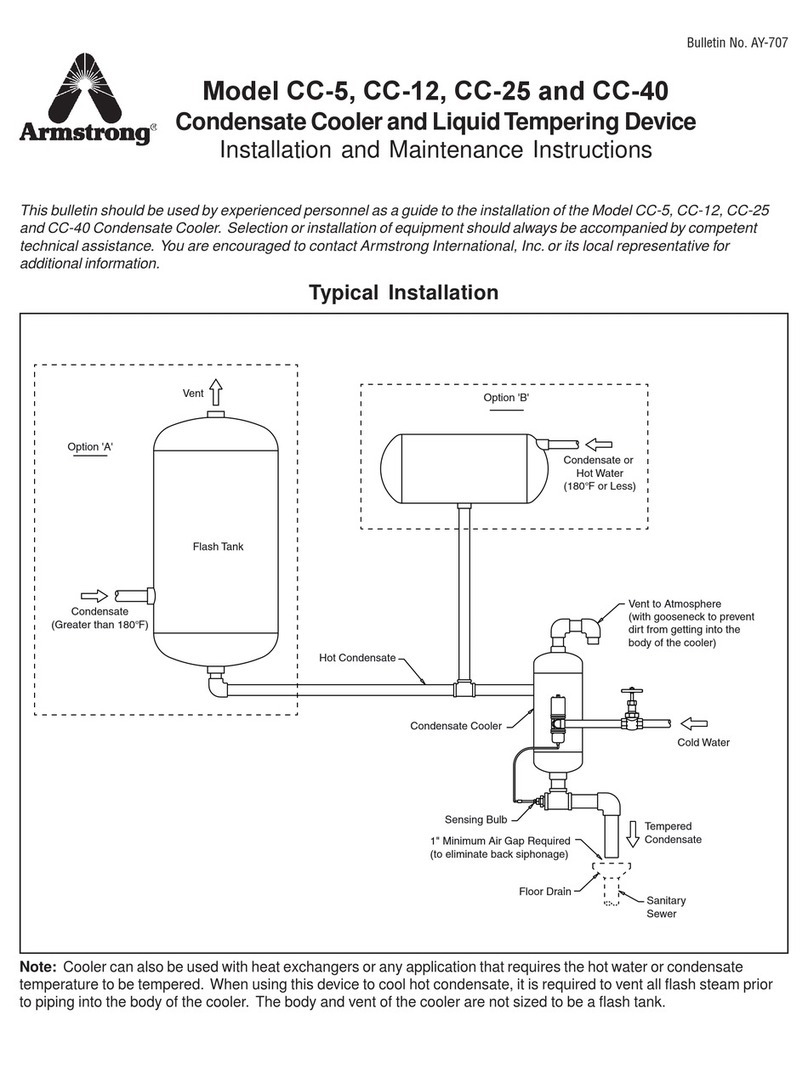
Armstrong
Armstrong CC-5 Installation and maintenance instructions

Godrej & Boyce Mfg. Co. Ltd.
Godrej & Boyce Mfg. Co. Ltd. 300L user manual
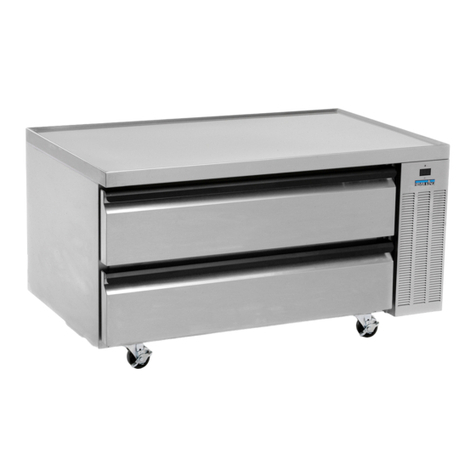
Silver King
Silver King SKFCB50H Technical manual and replacement parts list
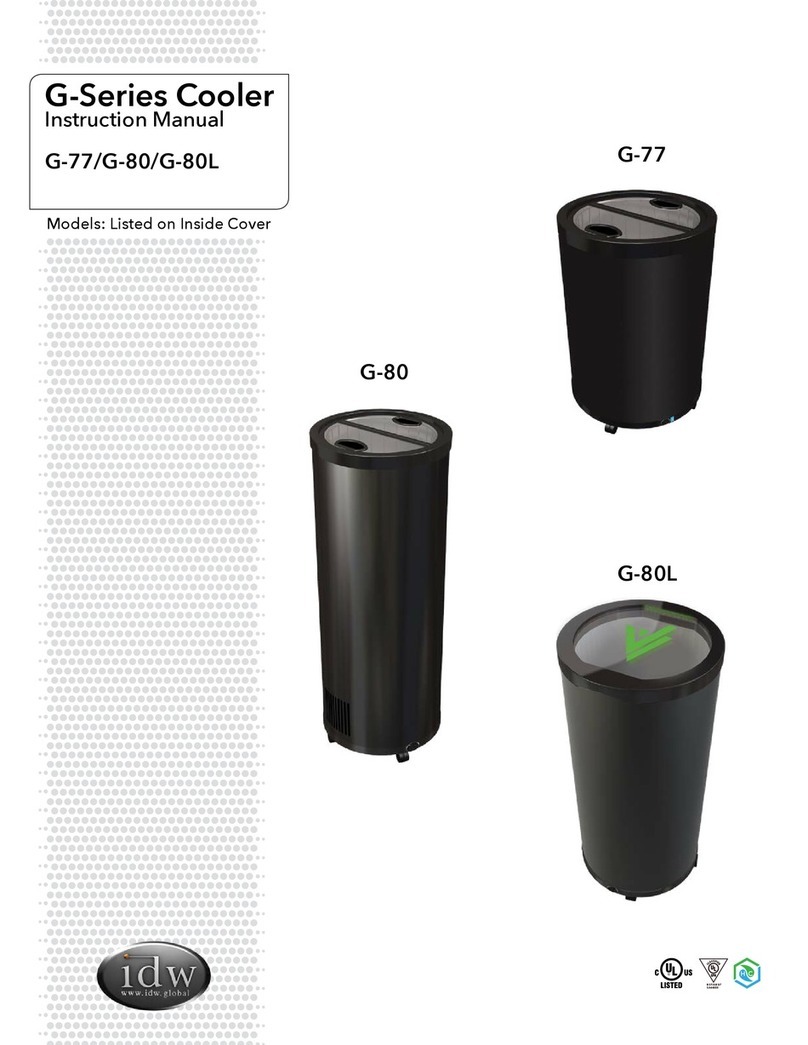
IDW
IDW G-Series instruction manual
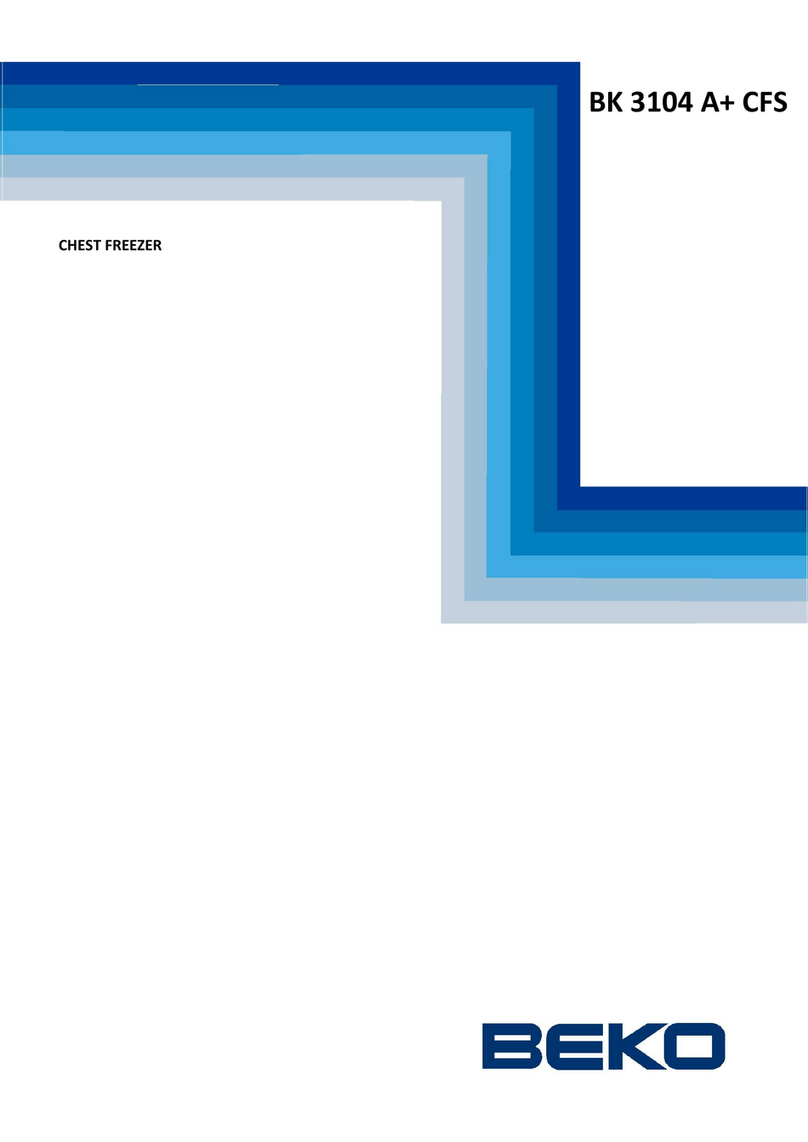
Beko
Beko BK 3104 A+ CFS quick start guide
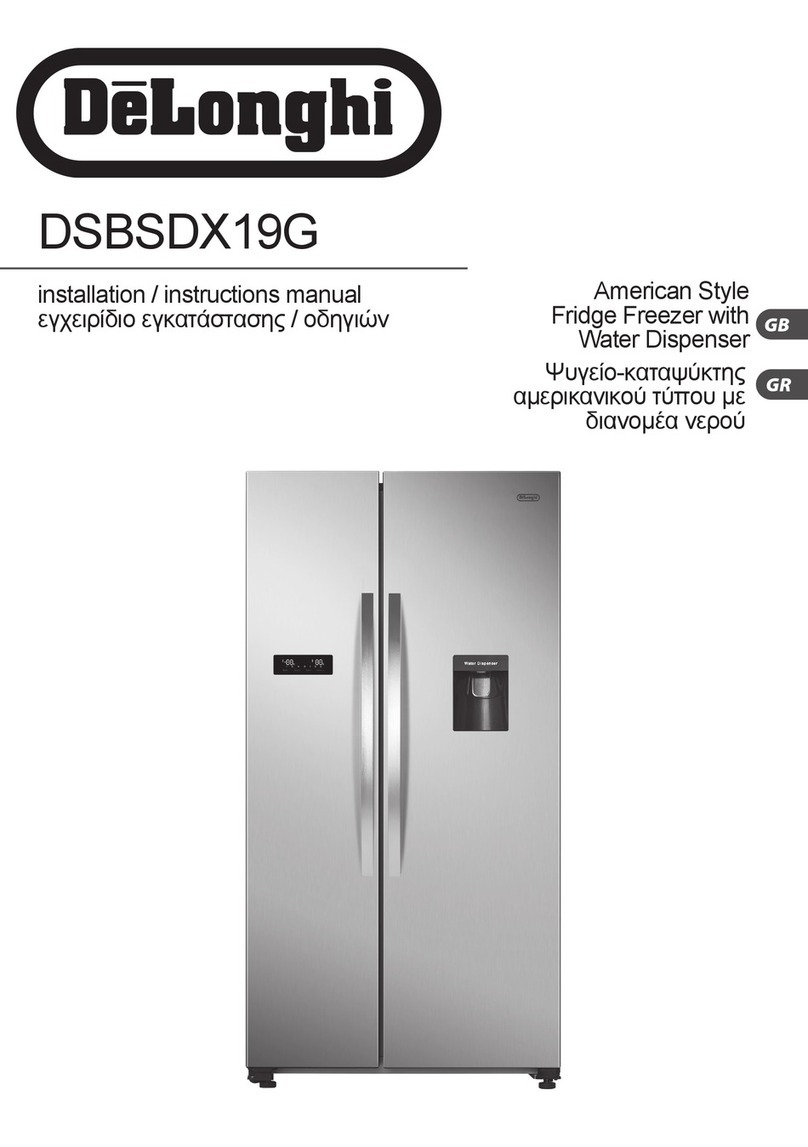
DeLonghi
DeLonghi DSBSDX19G Installation instructions manual
